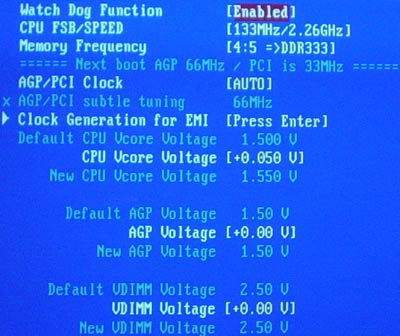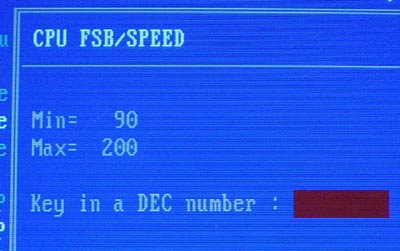Epox 4PEA+ (845PE): A well rounded 845PE
by Evan Lieb on October 17, 2002 2:08 AM EST- Posted in
- Motherboards
Epox 4PEA+: BIOS and Overclocking
Not surprisingly, Epox decided to choose the Award BIOS for the 4PEA+ motherboard.

The PC Health section of this particular version of the Award BIOS has lots
of good information. You'll find readings on CPU temperature, Vcore, PSU readings
(all rails), and CPU, Power, and Chassis Fan speed readings; there's also an
option for enabling the CPU warning temperature.

There were some fairly good DRAM tweaking options available in the Advanced Chipset Features section. You're allowed to adjust CAS Latency, Precharge to Active, Active to Precharge, Active to CMD, and timing mode. Unfortunately there were no Command Rate or Bank Interleave adjustments, but we can live with that, even though it would have helped us conduct more strenuous stress tests.

Epox allows some pretty normal FSB options in the BIOS. You're capable of adjusting the FSB up to 200MHz, which is enough for most overclockers. There are only two DRAM:CPU ratios available, 1:1 and 4:5. So you'll have to raise your FSB to 160MHz before your 4:5 ratio will allow you to do 400MHz, but since this board is capable of such a feat, we don't have a problem with that scenario. However, we weren't able to conduct any memory overclocking tests and stress tests due to the limited ratio options (a 3:4 ratio obviously would have been nice). The Epox 4G4A+ (845G chipset) allowed a 3:4 ratio in its BIOS, so adding the feature to the 4PEA+ shouldn't be too difficult.

One of the features Epox boards bring to the table that no other motherboards can match is great voltage tweaking options. The best example of this is the VDIMM options you're given; you can adjust VDIMM as high as 3.2V in 0.1V increments. This is a very high value; in fact, it's actually higher according to the PC Health reading in the BIOS. For example, at default VDIMM, the board actually supplies around 2.56-2.57V rather than 2.5V as was set in the BIOS. This is actually a well known trick in the motherboard industry of purposefully overvolting Vcore and VDIMM in order to increase tolerances and provide increased stability at the sacrifice of some long term reliability.


AGP voltage is also extremely adjustable, capable of as high as 2.2V in 0.1V increments. This level of VAGP is plenty for the video card overclockers out there. The final item on the voltage side of things is Vcore. Vcore is adjustable all the way up to 1.85V in the BIOS. Default Vcore (1.5V) in reality runs between 1.46-1.47V, meaning you can "only" go as high as about 1.8V. This is hardly a setback however, as 1.8V is way too much for an air-cooled Northwood Pentium 4 to operate at to begin with.
The Epox 4PEA+, like all the 845PE-based boards we've tested employs an AGP/PCI lock at 66MHz/33MHz. Overclockers and tweakers can always appreciate an AGP/PCI lock, since it's never a good idea to run your AGP or PCI cards too far out of spec.
The Epox 4PEA+ overclocked pretty much the same as all the other 845PE boards we've tested here at AnandTech. The following table lists the components we used for overclocking the FSB using the Epox 4PEA+:
|
Front Side Bus Overclocking Testbed |
|
|
Processor:
|
Pentium
4 2.26GHz
|
|
CPU
Vcore:
|
1.5V
(actual)
|
|
Cooling:
|
Intel
Retail HSF & Thermal Pad
|
|
Power
Supply:
|
Enermax
300W
|
With this setup we were able to hit 160MHz FSB. While this might seem on the low side of the 845PE overclocks we've written about here in the past week, it should be noted that we were able to get to 165MHz FSB (DDR412MHz) reliably on only an extra 0.05V of Vcore.

Out of the four 845PE boards we've tested here in the last ten days using our FSB Overclocking Testbed we've been able to average 162.75MHz FSB. This type of performance speaks volumes about the quality of the 845PE chipset itself. Of course, we don't presume to tell you that you'll be able to get the same results using the exact same setup listed in our FSB overclocking testbed; you'd have to be somewhat lucky to get as well an overclocking processor as we did. However, the average overclock we've seen with the low-end 2.X GHz P4 Northwoods tells us that 160MHz FSB shouldn't be too much to ask for even while using a conservative overclocking setup such as our own.
As was the case with the Gigabyte 8PE667 Ultra, we weren't able to do any extreme memory overclocking with the Epox 4PEA+ due to the limited BIOS ratios (which only included 1:1 and 4:5 ratios). The 4PEA+ has so far been the only 845PE-based motherboard not able to overclock memory past 400MHz. However, this is only because there was no 3:4 ratio in the BIOS and because we were unable to overclock the FSB past 160MHz using our standard FSB Overclocking Testbed.










1 Comments
View All Comments
jane909192 - Sunday, November 10, 2019 - link
Thanks a lot for the nice article follow https://onlinetechnicalhelps.com/windows-shortcut and save to all basic feature to users online.